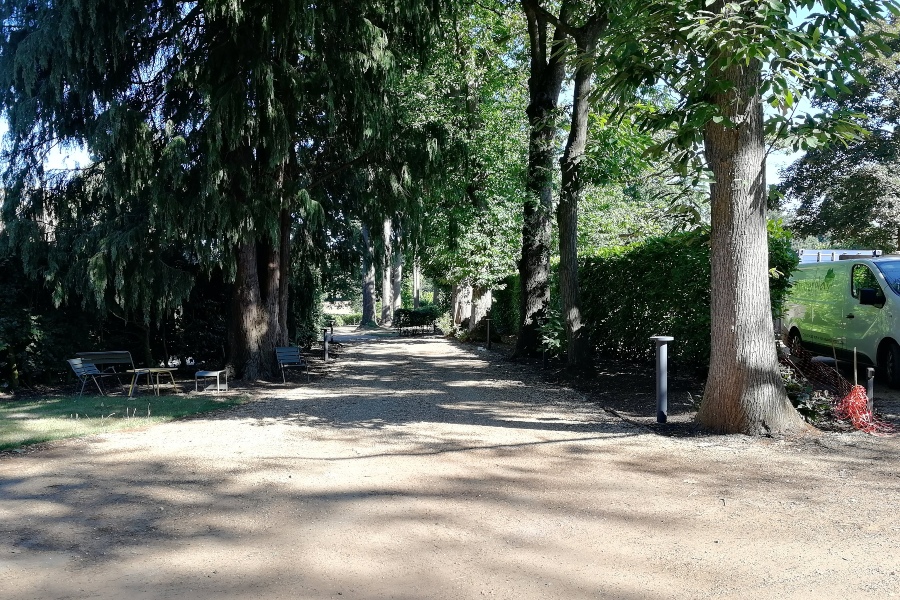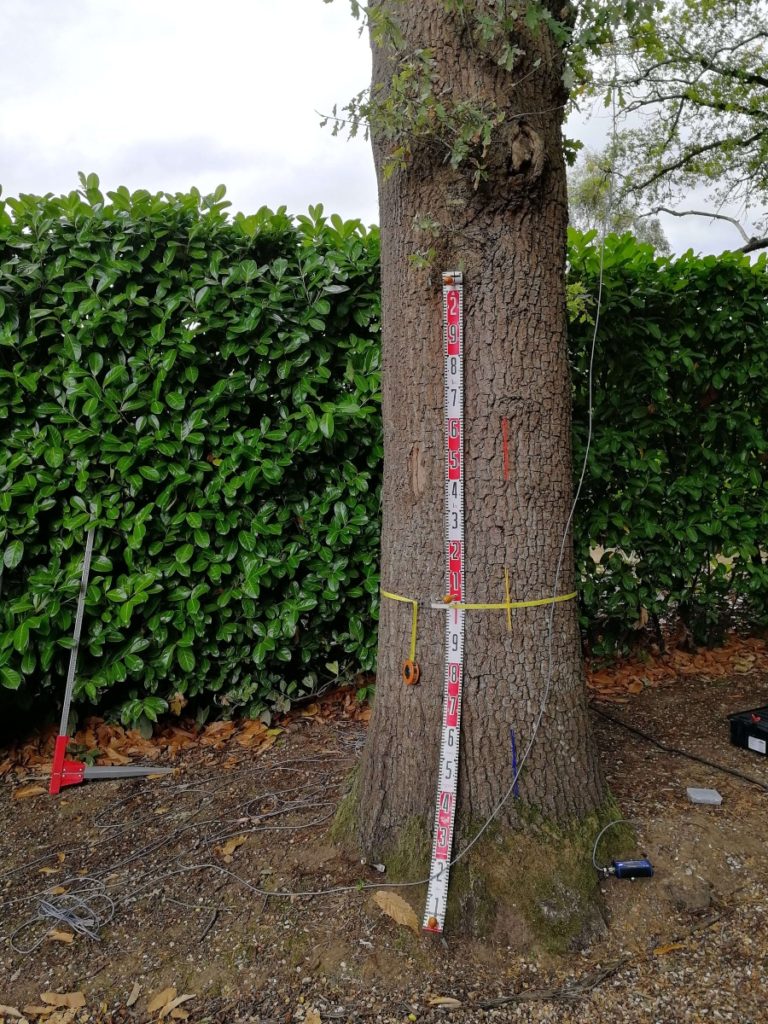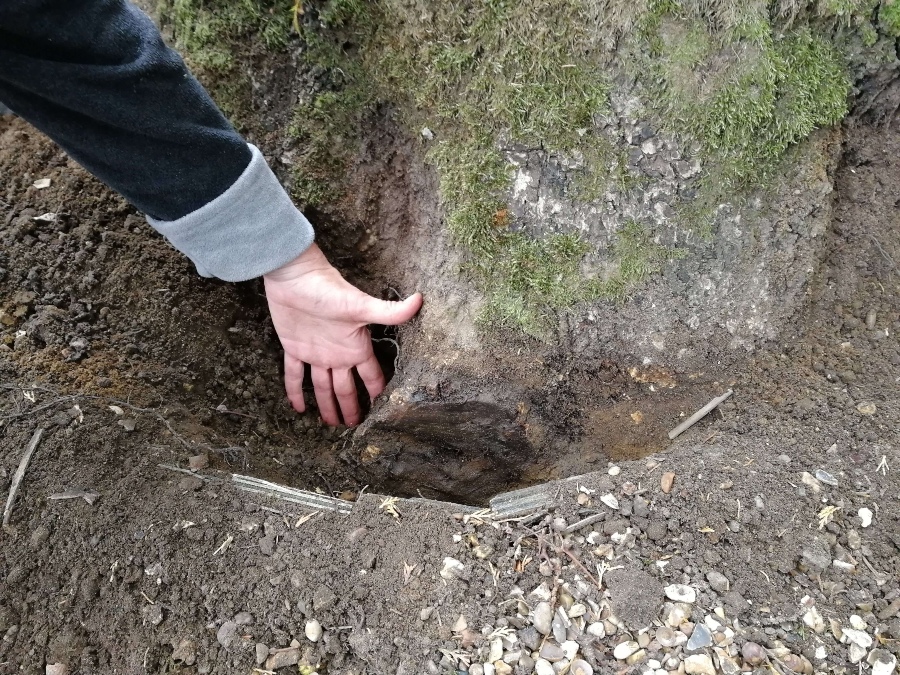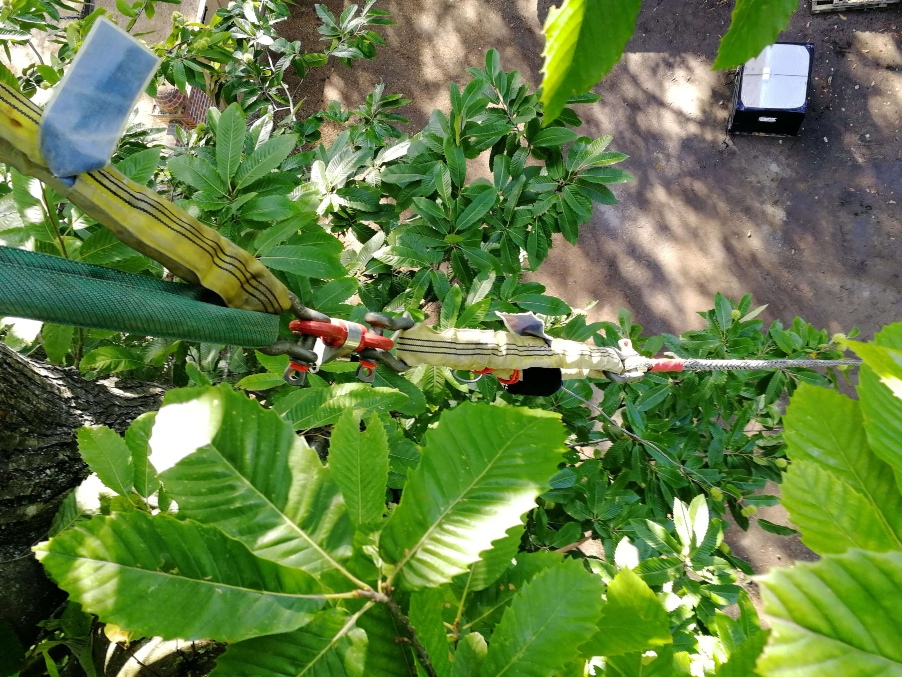The Driveway Project: Background

Before Reeves were hired, the client hired contractors to build a new driveway at their property. As part of the construction process the contractors used a basic trench excavation method very close to some mature trees.
Unfortunately, this showed a serious lack of consideration for how the excavation might damage the root system of the trees – a vital component in the health and structural integrity of a tree. Luckily, the landscape architect working at the same property, on a different project, flagged to the owners that this was a potential issue and so Reeves was called in.
Part 1: Root Damage Investigation, Remediation & Planning Permission

Reeves was brought in to investigate suspected root damage to multiple, mature, Sweet Chestnut, Oak and Fir trees. As Arboricultural consultants our remit was to investigate any potential root damage and consequential impacts on the affected trees.
In addition to this investigation, we were tasked with producing a report with remediation measures (actions to remedy environmental damage) and liaising with the local authority to help ensure planning consent. Planning permission had not been attained and the contractors had begun work without getting the approval of the local council, which could mean that if permission was not subsequently granted then all the work would have to be reversed.
Assessing Significant Root Damage With Static Load Testing

We proposed several investigative procedures to assess if any significant root damage had occurred, and to assess likelihood of windthrow – where trees are uprooted by wind. Our preferred method for assessing this is using static load testing, which the client agreed to.
For static load testing, a winch is used to apply a known load to the tree being tested. This tree is monitored and its reaction to the applied load is compared to a threshold load that the tree should be able to withstand during a storm event.
At the time of this project, there was only one UK company carrying out these tests: Treework Environmental Practice, a leading UK arboriculture consultancy. Working with them, we personally assessed the feasibility and practicality of these tests on this site and organised for two of their consultants, Paul Muir and Claire Harbison, to carry the tests out.
Static Load Testing Was Applied To 7 Trees
There were a number of trees in the area around the new driveway and we selected 7 trees to test, which were most likely to have had significant damage.

We helped Paul and Claire by installing winch cables and setting up measuring instruments over 2 days of testing. The results when fully assessed by the consultants were comprehensive and conclusive. 6 out of the 7 trees produced results with little or no reduction in root stability, meaning they could be safely retained. The 7th and last tree tested showed a significant reduction of root stability, and was in need of removal.
For this 7th tree, a result of 25 degrees inclination in the root plate with less than half a ton of applied force was achieved. This was a significant loss in stability and therefore a conclusive test that it was not safe to retain this tree. In fact, this was the most significant loss in stability that the consultants had encountered in their time using static load testing.
Static Load Tests Proved Their Value
The static load test was proven valuable by the clear results. It took away the assumptions and human judgement that would have been involved in excavations and assessment of visible root severance and instead provided quantifiable data.
The value of the tests was clearly evident given that an unsafe tree was removed and the tree owners didn’t need to spend any more money reducing or removing any of the other trees – which may have happened if a less conclusive testing method and safety first approach had been employed.
Treework Environmental Practice has written about the static load tests they carried out, which is available online for anyone to read through.
Reeves’ desire to be a small part of furthering the understanding of tree failure and the benefits of advanced testing methods, such as static load testing in arboriculture, led us to suggest to Paul and Claire to winch the 7th tree to the point of failure on an additional separate visit to the site, with the consent of the client. We carried it out with the Treework Environmental Practice team and it provided some valuable data for the consultants, which we were very happy to facilitate. We felled the tree in a controlled manner immediately after the point of perceived failure was reached. You can read about this case study and other destructive tests carried out by Treeworks online.
Remediation & Planning Consent
Having produced a report with our initial findings and recommendations for the tree owners, we liaised with the planning consultants and local authority. Following our meeting with the relevant Arboricultural officer, who was in agreement with our proposals, our remediation measures were formalised in a report to support the planning application. We also submitted the findings of the static load tests and the work we were carrying out throughout the site to reassure the local authority that everything possible was being done to remediate any previous damage caused and that all trees were now being managed to the highest possible standard.
Remediation Measures
We oversaw the following remediation measures for this project:
- The careful reinstatement of a ditch, which had been filled with excavated material within the rooting zones of multiple trees.
- The air spading (an air spade is a pneumatic device that uses compressed air to break up difficult soil safely and efficiently) of the trees affected by compaction caused by soil and material build up.
- The application of mulch in the areas where decompaction had taken place.
- The planting of 3 young trees to replace the tree lost and to compensate for potential future negative impacts/ losses.
- The planting of a new hedge along the new roadside fence line to replace the one that had been removed prior to our involvement with the site.
- The removal of all deadwood in trees that were likely to have been impacted by the construction so we could monitor future dieback and general health.
- A deadwood removal and sensitive reduction of a mature oak tree that had been impacted by the construction.
A little while after the remedial measures were complete, we were happy to be notified that retrospective planning consent had been granted.
Part 2- Arboricultural Survey, Further Investigations & Ongoing Management
During our investigation of the initial driveway construction work at the property, we noticed that there were other trees in need of management. We advised the client that a health and safety Arboricultural Survey for the whole site would be valuable. They agreed and we got to work.
Arboricultural Survey & Further Investigation Findings
As part of the Arboricultural Survey, we mapped all the trees on the property and provided comprehensive, prioritised recommendations. These ranged from trees that needed work or further investigation within 3 months, to trees that required no additional work.
Where possible we took a proactive but pragmatic approach to the trees on site, as we believe this is generally the best approach to tree management. We recommended further investigation to several trees that had significant cavities or decay present. One tree required a significant reduction and one tree required removal as it was considered unsafe to retain.
These internal investigations were carried out using a micro drill or PICUS Sonic Tomography system (SoT) by a specialist consultant with whom we have worked over a number of years.
Following the survey and internal investigations we carried out the different phases of recommendations, ensuring the tree owner had a clear understanding of the budget, time frames and reasoning behind all works from the outset.
Recommended Arboricultural Works
The recommended works encompassed the majority of the works that we or any other Arboricultural contractor carries out. This included:
- Full deadwood removals – removal of all deadwood present in trees affected by construction works so future dieback and overall health and condition could be assessed.
- Standard deadwood removals – removing all significant deadwood.
- A light reduction as part of a phased reduction on a mature oak tree impacted by the construction works.
- A range of other reduction works from light to 5m removal, depending on the significance of the defect that prompted the necessary pruning.
- Removal – felling and stump grinding.
- Installation of Cobra bracing – a flexible bracing system that minimises excess movement in areas where a defect is causing some potential weakening of the structure. Such a system allows some movement and therefore the beneficial reaction growth produced by the tree still takes place, but reduces the risk of failure and the need for pruning.
- Specific and selective reductions (rather than reduction of the entire crown) – reducing specific branches or sections of crown to minimise the risk of failure due to a defect present.
- Aerial inspections and subsequent recommendations/ pruning to properly assess tree health and safety by inspecting, recording and evaluating defects that are not visible/measurable from the ground.
- Application of mulch to aid moisture retention and improve soil and rooting conditions.
- Planting of young trees and a new hedge.
Ongoing Management & Benefits Of Our Preferred Method
Reeves Arboricultural Services continues to monitor and manage this site and the relationship with the site represents what we believe is the best form of service we can provide for clients and their valuable trees.
Carrying out a survey, the subsequent recommended works, and ongoing monitoring and works, puts us in a position to really get to know the trees we manage, and by extension the overall context of a site. We observe trees in different seasons, from the ground and aerially, and any changes that take place. This enables a connected and comprehensive management service which is often not achieved with multiple consultants and contractors providing surveys and tree works.
This site demonstrates the tangible benefits of our involvement. Be that in the removal of trees that would have otherwise been a danger to people and property, the retention of trees that were shown to be safe to retain, the new trees thriving and providing the future of the landscape, or the improvements in health and condition in so many of the trees. The positive impacts are evident throughout the site.
Although these benefits may be clear to us, it is always very reassuring to hear the opinions of others who confirm your views. A recent reassessment of our status as an Arboricultural approved contractor provided just that. The extremely knowledgeable and experienced assessor was very impressed with our management. He commented on our comprehensive and thorough approach, the high standard of pruning and planting and our clear commitment to well-rounded arboriculture. This view and our involvement in this site encompasses the exceptionally high levels of service we are committed to for all our clients and their trees at Reeves Arboricultural Services.
Conclusion: What We Achieved For Our Client
Although we were only brought on part way through a driveway project, we were able to not only remedy the situation but find additional ways to ensure tree safety on the site. We were able to successfully manage the assessment and the work, including applying static load testing with the support of specialist consultants, acquiring retrospective planning permission for the new driveway and carrying out a full site survey.
We feel this is an excellent example of not only the services we provide, but how we can help clients achieve success with complex projects and develop an ongoing relationship that benefits the client’s site and property.
